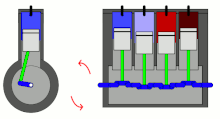Introduction to Engine Operation : (Saturn I4 Engine)
i) Definition of the Systems
 The powerplant used in Saturn S-series automobiles was a straight-4 aluminum piston engine produced by Saturn.
The engine was only used in the Saturn S-series line of vehicles (SL,
SC, SW) from 1991 through 2002. It was available in chain-driven SOHC or DOHC variants.
The powerplant used in Saturn S-series automobiles was a straight-4 aluminum piston engine produced by Saturn.
The engine was only used in the Saturn S-series line of vehicles (SL,
SC, SW) from 1991 through 2002. It was available in chain-driven SOHC or DOHC variants.This was an innovative engine for the time using the lost foam casting process for the engine block and cylinder head. Saturn was one of the first to use this casting process in a full-scale high-production environment. Both engine types used the same engine block.
Saturn I4 Engine - technical specs
Overview
|
|
Also called
|
|
Combustion chamber
|
|
1,901 cc
(116.0 cu in)
|
|
82.0 mm
(3.23 in)
|
|
90.0 mm
(3.54 in)
|
|
Cylinder block alloy
|
|
Cylinder head alloy
|
|
|
|
Combustion
|
|
Fuel system
|
|
Fuel type
|
|
Oil system
|
|
Output
|
|
Power output
|
|
|
|
Torque output
|
|
Dimensions
|
|
Dry weight
|
|
Chronology
|
|
Successor
|
|
the explanation of I4 engine
the explanation of balancing shafts in I4 engine

Inline-four engine
- 4 cylinders are less costly than 6 or 8 when you take into account the additional pistons, fuel injectors, spark plugs, and valvetrain components.
- An inline engine is less costly to produce than a V or boxer because the V and boxer will both have multiple heads and sets of valvetrain components and the blocks will be more complex.
- Reducing the number of cylinders for a given displacement (maximizing piston/cylinder size) will reduce the surface area available for heat transfer (loss) and will reduce the length sealed by piston rings. Both of these effects make a 4 cylinder engine more efficient than a 6 or 8 cylinder engine of equivalent displacement.
- 4 cylinder engines can be very easy to service as the engine can be accessed from the top. Often boxer engines and V engines are more difficult to service, especially in tight engine bays, because the main components aren't pointing "straight up."
The inline 4 cylinder engine is in primary balance but not secondary balance, but the balance issues that this configuration has are not insurmountable and dealing with them does not outweigh the other benefits this configuration provides. As far as balance, one of the best engines for balance is an inline 6 (which is in perfect primary and secondary balance), but inline 6 engines are only used in limited applications because they're very long and difficult to fit in a short engine bay. Many inline 4 cylinders are transversely mounted for front-wheel-drive cars. Longer engines (such as an inline 6) are much easier to mount front-to-back and as such are more popular in rear-wheel-drive applications such as certain sports cars and trucks.
While additional cylinders have often been the answer for more power in the past, now manufacturers are often turbocharging their engines to increase the power output of the engines in an effort to get more power from smaller engines and raise fuel economy, thus reducing the need to move up to a V6 engine.
Engineering in general (especially automotive) is often about deciding between different tradeoffs. While the inline 4 cylinder engine isn't perfect it has a number of attributes which make it highly attractive and aren't outweighed by its drawbacks.

No comments:
Post a Comment